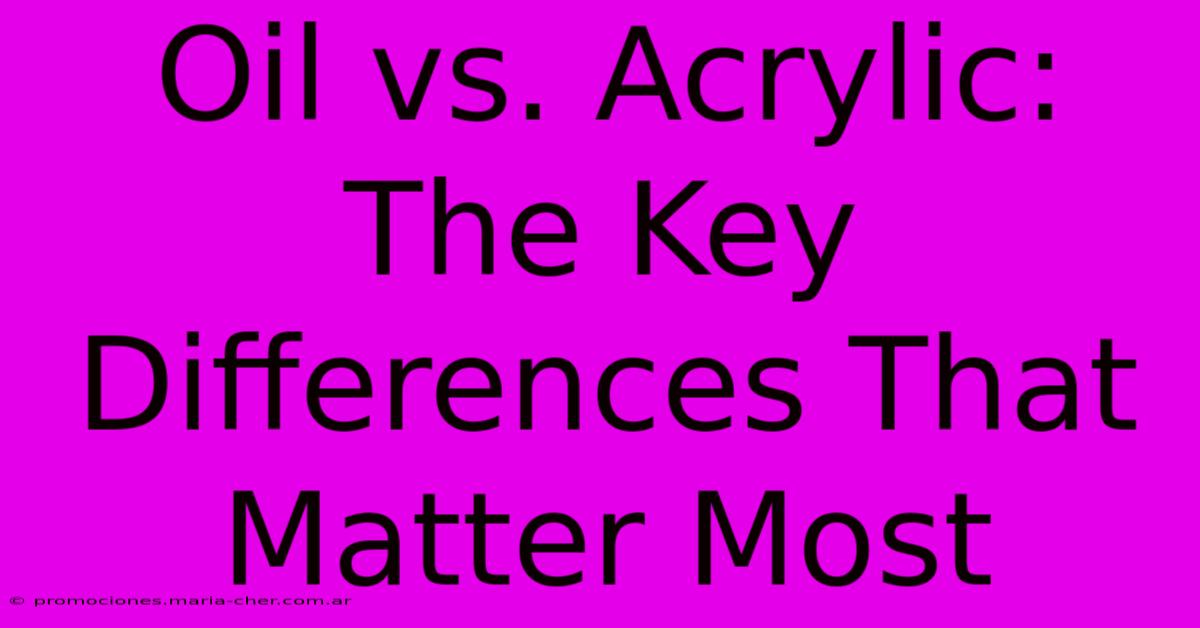Oil Vs. Acrylic: The Key Differences That Matter Most

Table of Contents
Oil vs. Acrylic: The Key Differences That Matter Most
Choosing between oil and acrylic paints can feel overwhelming, especially for beginners. Both mediums offer unique characteristics and advantages, making the "best" choice entirely dependent on your individual needs and artistic style. This comprehensive guide will delve into the key differences between oil and acrylic paints, helping you make an informed decision.
Drying Time: The Biggest Distinguishing Factor
Perhaps the most significant difference lies in drying time. Oil paints dry incredibly slowly, sometimes taking days or even weeks to fully cure. This slow drying time allows for extensive blending, glazing, and layering, offering artists incredible control and flexibility. You can easily rework sections and achieve subtle transitions.
Acrylic paints, on the other hand, dry remarkably fast. This rapid drying time can be both a blessing and a curse. While it allows for quick work and multiple layers in a single sitting, it also limits blending opportunities and can lead to frustrating brushstrokes if you're not careful. The fast drying time also means you need to work quickly and efficiently.
Impact on Artistic Style:
- Oil paints: Ideal for artists who enjoy meticulous detail, glazing techniques, and a more traditional approach to painting. The slow drying time allows for complex layering and rich, luminous effects.
- Acrylic paints: Perfect for artists who prefer a fast-paced, spontaneous style. The quick drying time is advantageous for creating bold, vibrant strokes and is well-suited to techniques like impasto.
Texture and Application: Exploring the Nuances
Both oil and acrylic paints offer a range of textures and application methods, but there are subtle differences:
Texture:
- Oil paints: Typically have a smoother, more buttery consistency, offering a luxurious feel during application. They can be thinned with mediums like linseed oil to achieve a wide variety of textures, from thin washes to thick impasto.
- Acrylic paints: Can range in texture, from thin washes to thick impasto, but generally tend to be less buttery and more pliable than oil paints. Water is commonly used as a thinner, influencing texture and consistency.
Application:
- Oil paints: Can be applied with a variety of tools, including brushes, palette knives, rags, and even fingers. The slow drying time enables a more forgiving approach to layering and blending.
- Acrylic paints: Similarly versatile in their application methods, but the faster drying time necessitates a quicker and more deliberate approach.
Clean-up and Maintenance: Practical Considerations
Clean-up is another area where oil and acrylic paints differ significantly.
- Oil paints: Require solvents like turpentine or mineral spirits for cleaning brushes and palettes. These solvents have strong odors and require proper ventilation.
- Acrylic paints: Clean up easily with water and soap. This makes them a more convenient option for many artists, especially those with environmental concerns or limited space.
Cost and Availability: Factors to Consider
Generally, oil paints tend to be more expensive than acrylic paints, although the price can vary based on brand and quality. Acrylic paints are more widely available in art supply stores, making them a more accessible option for many beginners.
Longevity and Preservation: Which Medium Lasts Longer?
Both oil and acrylic paints, when applied correctly and cared for properly, can last for many years. However, oil paintings generally have a longer lifespan, potentially lasting for centuries. Acrylic paintings are also durable, but their longevity can be affected by factors such as the quality of the paint, the surface it's applied to, and environmental conditions.
Conclusion: Choosing the Right Medium for You
The choice between oil and acrylic paints ultimately depends on your personal preferences, artistic style, and practical considerations. There's no single "right" answer. Experimenting with both mediums is highly recommended to discover which one resonates best with your creative process. Consider the factors discussed above – drying time, texture, clean-up, cost, and longevity – to make an informed decision that sets you up for success in your artistic endeavors.

Thank you for visiting our website wich cover about Oil Vs. Acrylic: The Key Differences That Matter Most. We hope the information provided has been useful to you. Feel free to contact us if you have any questions or need further assistance. See you next time and dont miss to bookmark.
Featured Posts
-
Unleash The Mystical Power Of The D And D Cat Eye Magnet A Treasure For Your Kitty
Feb 10, 2025
-
Witness The Transformation D And D Gel Walnut Browns Magical Touch
Feb 10, 2025
-
Unlock A Meaningful Remote Work Journey Compassion Internationals Global Mission
Feb 10, 2025
-
From Expert To Novice Why Embracing A Beginners Mind Is The Key To Innovation
Feb 10, 2025
-
Sewing Vs Sowing A Stitch In Time Or A Scattered Harvest
Feb 10, 2025
